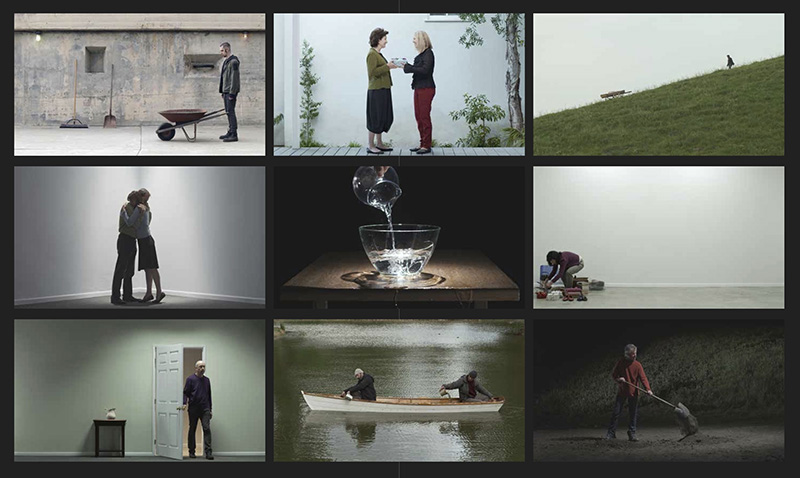ART CITIES:Bilbao-Bill Viola
 Bill Viola began to experiment with video art in the early ‘70s through his participation in the Experimental Studios program at Syracuse University in New York) directed by Jack Nelson. In Syracuse he met the curator of Video Art David Ross and assisted artist Peter Campus and Nam June Paik at the Everson Museum of Art. With his interest in Eastern and Western mysticism, philosophies and poetry, Viola used the technical potential of video as a tool for a lifelong inquiry into the human condition, including birth and death, and the processes of change, rebirth, and transformation, all of which are prominent themes in his work.
Bill Viola began to experiment with video art in the early ‘70s through his participation in the Experimental Studios program at Syracuse University in New York) directed by Jack Nelson. In Syracuse he met the curator of Video Art David Ross and assisted artist Peter Campus and Nam June Paik at the Everson Museum of Art. With his interest in Eastern and Western mysticism, philosophies and poetry, Viola used the technical potential of video as a tool for a lifelong inquiry into the human condition, including birth and death, and the processes of change, rebirth, and transformation, all of which are prominent themes in his work.
By Efi Michalarou
Photo: Giggenheim Museum Archive
The exhibition “Bill Viola: A Retrospective” reaches back to his early days in video art and includes Viola’s single-channel videotapes “Four Songs” (1976) and “The Reflecting Pool” (1977-79). In his works from the ‘80s, after Kira Perov (his wife and long time collaborator) began to work with Viola, his focus was on gathering footage for use in broadcast pieces. He used the camera and special lenses to capture the landscape and record images normally beyond our perception. This period also served as a transition toward his whole room installations of the ‘90s that immerse the viewer in images and sound. He also began adding physical elements to his works. Viola’s continuing interest in spiritual themes can be seen in sculptural objects like “Heaven and Earth” (1992) and in large installations like “Slowly Turning Narrative” (1992). With the arrival of the new millennium and the advent of high-definition flat screens, Viola began producing small and medium-sized works in a series he titled the “Passions”, a study of the emotions in slow-motion, such as Surrender , or that depict the passage of time and generations. Over the last decade, through a variety of media and formats, Viola has continued in his work to depict the fundamental experience of life. This is eloquently illustrated by his use of water in works such as “The Innocents” (2007), “Three Women” (2008), and “The Dreamers” (2013) and his journey through the cycle of life. “Four Songs” (1976) is a collection of four musical stories in allegorical form. Images and sound are composed into audio-visual rhythms based on the psychological/emotional dynamics of the individual interaction with the environment. Many of the characteristic features of the artist’s oeuvre can already be seen in these early single-channel videotapes in his use of repetition, of slow motion, and of long dissolves. In “Chott el-Djerid” (1979), Viola works with telephoto lenses adapted to video to overcome the limits of our sight and record the mirages generated by heat waves in the landscape, which are usually attributed to the illusions created by our own brain. In “Slowly Turning Narrative” (1992), a rotating screen with a reflecting surface on one side and screen material on the other, situates the viewer at the center of the scene while two projections depict from one projector a close-up of a man’s face, his voice heard chanting, and on the other, a series of color images. Both are distorted as the screen rotates, the mirrored side reflecting images of the projections and our own reflection. “The entire space becomes an interior for the revelations of a constantly turning mind absorbed with itself” says the artist. “Going Forth By Day” (2002) is a monumental work commissioned by the Deutsche Guggenheim, Berlin. Made up of five large high-definition video projections, it explores a range of themes related to human existence, including individuality, society, death, and rebirth. Its title derives from the literal translation of the Egyptian book of the death, the work is a guide to help the soul emerge into the light of day once it is freed from the darkness of the body. The five parts: “Fire Birth”, “The Path”, “The Deluge”, “The Voyage” and “First Light”, are projected directly onto the walls, and are influenced in part by the fresco cycles of the Italian Renaissance artists Giotto and Luca Signorelli. The production was the largest that Viola had attempted to date, requiring a team of professional collaborators: director of photography, producers, special effects, lighting, art directors, wardrobe stylists, stunt people, sound engineers, editors, and many extras. Using the latest high-definition moving image technology, Viola’s vision displays, in the medium of video, a story that reflects the most essential human themes, extensively represented throughout art history. Made up of nine screens in three horizontal rows, “The Chapel of Frustrated Actions and Futile Gestures” (2013) leads viewers to reflect on the actions we perform repeatedly, day after day, and on our need for rupture or change. On one of the screens, the artist includes a reference to Albert Camus’s philosophical essay on the Greek myth of Sisyphus, whom the gods condemned to perpetually push a giant stone up a mountain, only to see it roll down again, with the consequent sense of frustration that all futile acts generate.
Info: Curator: Lucía Agirre, Guggenheim Museum Bilbao, Avenida Abandoibarra, 2, Bilbao, Duration 30/6-9/11/17, Days & Hours: Tue-Sun 10:00-20:00, www.guggenheim-bilbao.eus







